A how-to guide on fishing the Pipe Pool on the Welsh Dee at Llangollen
Introduction
To share my knowledge I’ve produced this guide on fly fishing the Pipe Pool.
It’s a lovely pool for fly fishing, which is fishabe from both banks without the need to wade; a bonus for beginners and those not comfortable with wading.
The Pipe is one of my favorite pools where I have caught 100’s of trout and grayling. In addition, salmon and sea trout are often caught in this pool but mainly on the spinner.
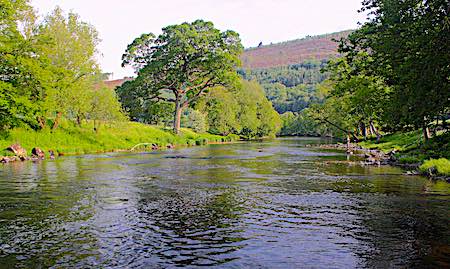
Fly fishing the Pipe Pool for trout and grayling:
Most fly fishing anglers tend to fish the Pipe Pool from the right bank because it’s easy to access and above the pool, there is a good mile of fishing to the end of the beat. However, on sunny afternoons the fish are easily spooked from the right bank.
The river flows south through the Pipe Pool and on sunny afternoons it is much better to fish from the left bank (east side of the river) because it’s easy to cover the fish without spooking them.
Fishing the Pipe Pool from the right bank:
The Pipe Pool is long and has several places where trout and grayling lie when the river is close to its summer level (< 0.6m Manley Hall gauge). I have produced the following sketch to help with my explanation on how to fish the right bank.

The fast water at the head of the pool (point A to B) has cut deep gullies and pockets into the bedrock, which are good lies for trout and grayling.
Rock ledges, either side of the head, funnel the main flow through the center of the pool. The creases along the ledges are good fish taking zones.
Whereas, the main body of the pool is a deeper section (point C to D) and the riverbed is composed of gravel and small boulders. On average, the trout and grayling caught in this section are smaller.
The tail of the Pipe Pool starts at point D, which is ca 4 ft deep when the river is at its summer level (0.5m Manley Hall gauge).
Fish caught in the tail section range up to 2lbs in weight.
There are a number of approaches that can be taken to fish the Pipe Pool. However, for this guide I’ve chosen the one that’s helpful to someone who hasn’t fished this pool before.
Fly fishing the tail of the Pipe Pool (point D):
On traveling upriver from the carpark you’ll reach the tail of the pool (point D), where there’s a gap between the trees. Here, it’s best to fish with either the wetfly or drylfy, when the river is running clear and close to its summer level (<0.6m Manley Hall gauge).
Fish as much of the river from the bank before wading out because trout & grayling often feed in the foam line a couple of rod lengths out.
If the river is at its summer level, I then will wade out at a downstream angle, and fish towards the large trees on the far bank (point E); where trout and grayling lie in the shade of the trees.
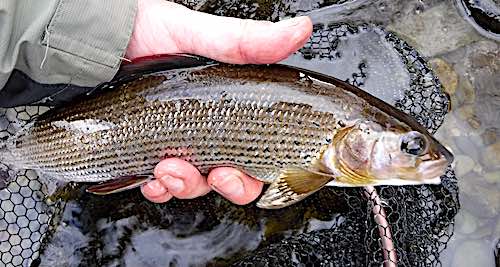
Fly fishing the body of the Pipe Pool (point C):
After fishing the tail, I move up to fish from point C on the sketch, which is just below the style into the next field.
This place is not easy to fish because of the large back eddy that extends out to the center of the river. However, it’s often worth fishing the crease of the back eddy with the dryfly, especially when fish are rising there.
Fly fishing the head of the Pipe Pool (point B to A):
Moving upriver, point B is the next spot to start fishing. Usually, the best approach here is to stay on the bank and cast upriver and fish the dryfly through the near-side seam of the main channel.
The section up to point A has several fish lies on the near-side of the main channel. Therefore, take your time and fish it thoroughly.
Once I’ve fished to point A with the dryfly, I will often switch over to fishing a team of wetflies/spiders across and downriver.
This allows me to cover the lies on the far side of the main current back to point B and usually produces a few extra trout and grayling.

Fishing the Pipe Pool from the left bank:
Fishing the Pipe Pool from the left bank offers another approach to catching the many trout and grayling that hold in this pool. The left bank is best fished when the river is close to its summer level (< 0.6m Manley Hall gauge), using both dryfly and wetfly fishing techniques.
To help with my explanation on how to fish this pool from the left bank I have produced the following sketch.
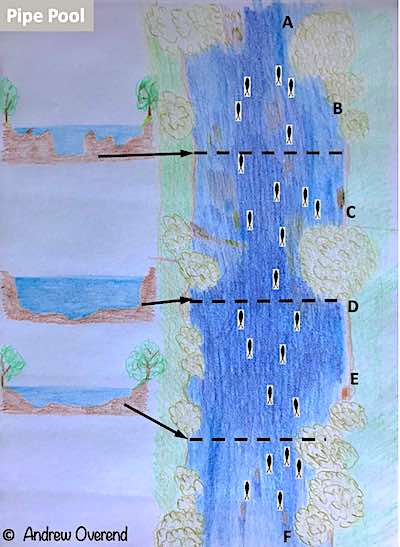
Fly fishing the left bank from A to B:
Usually, I start fishing left bank at point A with a team of wetflies and/or spiders. I cast the flies slightly upriver and allow them to dead drift down and then swing round to the dangle.
Takes often occur as the flies swing round to the dangle in front of the submerged rocks opposite point B.
After fishing through with the wetfly, I will go through this section again with a team of nymphs fished close to the riverbed.
Especially, when it’s a bright day and the river is very low because trout and grayling move up into the deep channel just below the rock outcrop opposite A.
Fly fishing the left bank from B to C:
Fish this section from the safety of the bank because the riverbed contains patches of polished slate, which is extremely slippy.
I’ve lost count how many times I’ve take a dip wading from B to C.
In the river between B and C, there are a number of submerged rock ledges, behind which fish lie in the slack water. I often fish this section with the wet flies, casting them into the slack zones…
Takes often occur as soon as the flies land…
So, be prepared to respond with a quick lift of the rod to take up any slack line and hook the fish.
It’s not uncommon to catch several trout and grayling fishing from B to C.
Fly fishing the left bank from D to E:
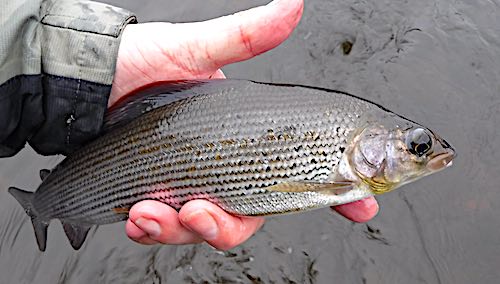
Opposite point D there is a large submerged rock ledge near the bank that deflects the main flow out into the center of the river.
Below the rock ledge, there is a deep hole that has been cut out by back-eddy.
I’ve fished this deep hole in many different ways but I have only caught the odd trout of grayling. Maybe one year I will crack how to fish this section.
So, be prepared to respond with a quick lift of the rod to take up any slack line and hook the fish.
It’s not uncommon to catch several trout and grayling fishing from B to C.
Fly fishing the left bank from E downriver:
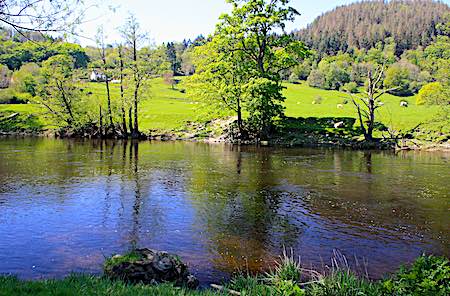
At point E, under the first tree, I will wade and fish down the pool to the end of the tail when the river is at its summer level.
More often than not, I will fish this section of the pool with a team of wet flies or spiders by casting the across the river, and allow them to dead-drift before letting them swing round to the dangle.
If fish are rising and ignoring the wetfly I will switch to dryfly fishing. On the other hand, if there is no surface activity I will fish a team of nymphs close to the riverbed (Euro / Czech nymphing style).
Fishing the Pipe Pool - how does my approach change with the season:
Fly fishing the Pipe Pool in March:
March signals the start of spring and the brown trout fishing season on the Welsh Dee (3rd March). However, the weather in March is often more like winter than spring. [N.B. if it has been a wet winter the river is often too high (> 0.7m Manley Hall gauge) to fish this pool]
On mild days, hatches of large dark olives and March Browns usually start around 11 am and you will often spot trout picking them off as they drift through this pool.
Druing these hatches, my approach is to target the rising fish with the dry fly (large dark olive or March Brown pattern).
Alternatively, fishing a team wet flies on a floating line often yields some beautiful over-wintered brown trout. The following is one of my default team of wet flies/spiders.

If either of the above fails, I will try my luck fishing the pool with a couple of nymphs suspended under a sight fly (Klink & Dink method).
For more information on the fly selection for fishing during March check out the following article:
Winter can return at the end of March and occasionally with a surprise…
The following picture is of a kelt I caught fishing a team of wet flies through the tail of the Pipe pool at the end of March. It fell for the size 12 black Pennell point fly and certainly warmed up a very cold day on the Welsh Dee.

Fly fishing the Pipe Pool in April:
Once April arrives, the weather usually starts to warm up and hatches of Large Dark Olives, March Brown, Grannom, and other olives become more prevalent from mid-morning to mid-afternoon. Hence, providing more opportunities to catch brown trout on the dry fly, by matching the hatch.
More information on the fly selection for fishing during April is covered in the following post.
Fly fishing Pipe Pool in May:
As the weather warms and dries up during May, fly hatches become prolific and brown trout become egaer to fatten up on the emerging fly life. Examples of flies you will see include:
Upwinged flies:
- Blue-winged olive
- Large dark olive
- Medium olive
- Iron Blue Dun
- Pale Watery Dun
- Olive Upright
- Yellow May Dun
Sedges:
- Black sedge
- Grannaom
- Cinnamon sedge
- Medium sedge
Others:
- Hawthorne fly
- Alderfly
- Large stonefly
- Midges
As a result of all the fly-life, May is when dry-fly and upstream wet-fly fishing produce the best catch results, when you have identified which flies the trout are taking.
The river flows through the Pipe Pool in a southerly direction. Therefore, it’s best fished in the morning from the right bank and in the afternoon from the left bank.
On overcast days, the fishing can be good from morning to dusk but on sunny days it dies off between 1 pm to 4 pm because there is a lack of shade on this pool.
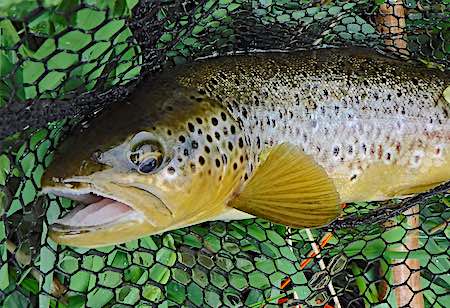
Fly fishing the Pipe Pool from June and August:
When the river is low during the summer months, fast, oxygenated water at the head of the Pipe Pool is a good place to fish. On sunny days, the best fishing is early morning and after 5 pm.
More information on the fly selection for summer is covered in the following posts.
Fly fishing the Pipe Pool in October:
My attention turns to grayling fly fishing from October to the end of February on the Welsh Dee.
During autumn and winter, river conditions often dominate my grayling fishing activities and I will only fish this pool if the river is running clear and the level is below 0.7m (Manley Hall gauge).
During October on the Welsh Dee fly hatches are still common on most days. The flies you are likely to see hatching include:
- Iron Blue Dun
- Pale Watery Dun
- Olive Upright
- Egg laying Stoneflies
- Midges
The approach to fly fishing the Pipe Pool depends on river height, water and weather conditions. On October mornings it tends to be a cool start and fly hatches don’t really get going until mid-morning.
If I’m on the river before 10am I will start fishing the pool from close to the bank with a team of wet flies by casting the flies across to the far bank and allowing them to swing round to the dangle.
My default wet fly recommendation is the following team of three flies cast on 3lb copolymer (point: March Brown spider #14; middle dropper: black hopper #14; top dropper: claret spider #16).
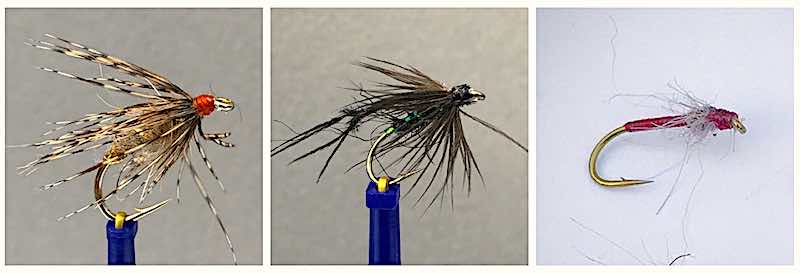
Once flies are observed hatching I will switch to targeting rising grayling with the dry fly. Ideally, it’s best to try and identify the flies that are being taken and tie on a suitable imitation.
If that is not possible, I usually start with a CDC olive emerger pattern that has served me well, and if that doesn’t work I start working through my fly box. However, it’s rare not to catch a grayling on one of the three following patterns:
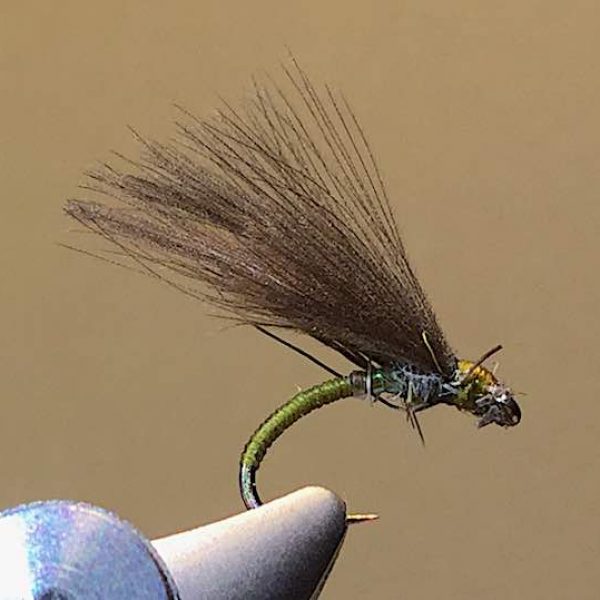
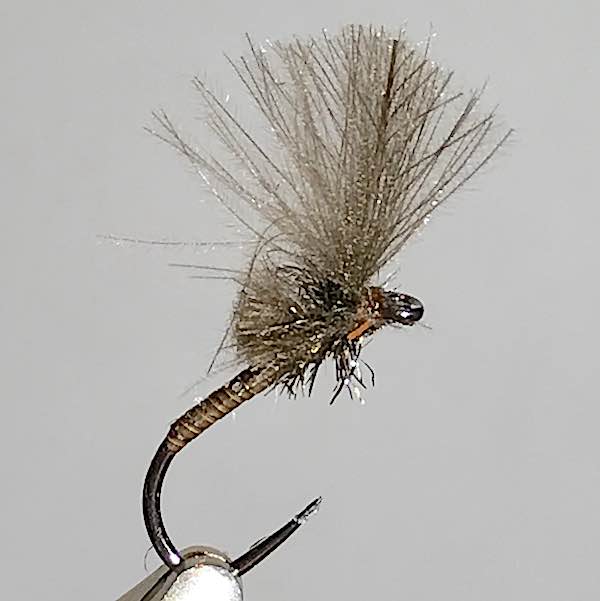

On rare occasions it’s not possible to tempt grayling with either of the above approaches, it is necessary to switch to fishing nymphs close to the riverbed. For most of the Pipe Pool, this is best achieved using the ‘Klink & DInk’ method to search the deeper channels.
Check out the link below for additional reading on flies for October:
Fly fishing the Pipe Pool in November:
The clocks go back at the end of October and the days get inceasingly shorter during November. With aquatic life becoming dormant for winter, flie hatches are sparse, and grayling are increasingly searching the riverbed for food: nymphs, larvae, worms etc.
Fishing for grayling during November can be great sport because they have to feed hard to ensure they are in peak condition for spawning in spring.
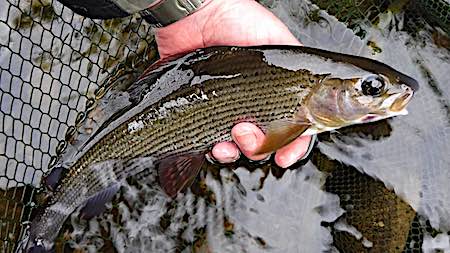
On November mornings fishing a team of nymphs under a bung often yields the best results.
Sporadic hatches of olives usually occur around lunchtime on mild days. If this happens then switching to fishing dry or wet flies often is the best approach.
For more information on the flies to use on the Welsh Dee during November check out the following article:
Fly fishing December,January & February:
Once winter sets in, the Welsh Dee is more often than not in flood during the winter months, and the opportunities to fish the Pipe Pool diminish.
However, if the river level is below 0.7m (Manley Hall gauge) it is definitely worth fishing because grayling shoal in the pool before spawning in the spring.
My approach to fishing this pool during the winter months is very similar to that used in November.
During the winter months, fishing the tail of the pool from the left bank is usually the place I caught most grayling.
For more information on the flies to use on the Welsh Dee during winter check out the following articles:
Fishing the Pipe Pool for sea trout:
The main run of Welsh Dee sea trout populate the pools above Llangollen during July and a few sea trout rest up in the Pipe Pool during their journey upriver.
I rarely fish the Pipe Pool for sea trout after dark because I preferer to fish other pools on the beat. However, I do fish the pool for sea tout during the last couple of daylight using small wet flies for the last hour of daylight.
The setting sun is behind you on the right bank, therefore, it is much better to fish the pool from the left bank.
My approach is quite simple I start at the head of the pool and work my way to the tail fishing a team of small wet flies on a 3lb copolymer leader. For fly selection check out the link to the post on daytime sea trout fishing.
When you get a take, once you have set the hook, you just have to let the fish take off until you know what’s on the end of the line; because it is just as likely to be a big grayling or brown trout than a sea trout.
The biggest sea trout I’ve caught fishing the Pipe Pool was 2lbs, with most being in the 1lb bracket; but it still great sport.
Fishing the Pipe Pool for Salmon:

Every year, I see resident salmon jumping in the Pipe Pool but they are not easy to catch on the fly.
To help you with where to focus your salmon fishing activities in the pipe pool I have produced the following sketch show where they typically lie.
I have had a few salmon take the fly but have only managed to land one, a red cock salmon of about 10lbs. It was caught fishing a Curry’s red shrimp on a sink-tip line.
From September onwards I fish this pool with fly from both banks when the river level is between 0.6 and 0.8m (Corwen gauge). Using either use a floating line with a 12ft copolymer tapered leader (12lb tip) or a sink-tip line when the river is slightly coloured.
For fly selection, I normally follow this simple approach
- In clear water I use size 10 or smaller drab coloured fly (e.g. Stoats tail, Blue Charm, etc)
- In coloured water a size 10 or higher brightly coloured fly (e.g. Cascade, Park shrimp etc).

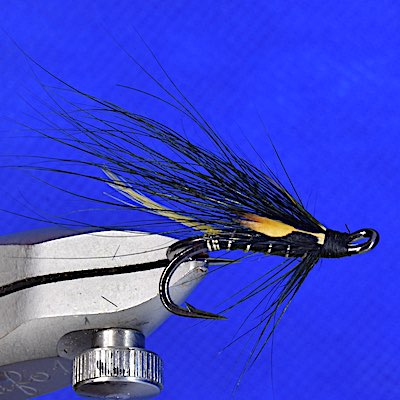
How to get to The Pipe Pool:
From Llangollen take the A5 to Crown and after the B5103 junction by Berwyn Station take the next right. Follow the lane for 500m to the lay-by on the left, by the railway tunnel.
Access the river by walking 50m down the lane and climb over the style on the right. Head upriver passed the Hollybush Pool and over the style into the next field. The Pipe Pool extends to above the next style. A map of this pool can be found on the Llangollen-Maelor Angling website.
Like most outdoor sports, fishing is not without its hazards. Therefore, YOU MUST DO YOUR OWN RISK ASSESSMENT before starting fishing the Pipe Pool. Especially if you decide to wade and/or fish at night. In addition, you must follow the Llangollen-Maelor Club Rules when accessing and fishing this water.